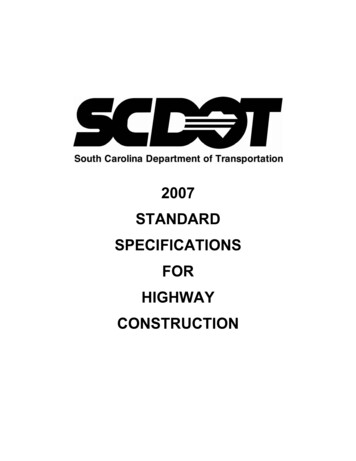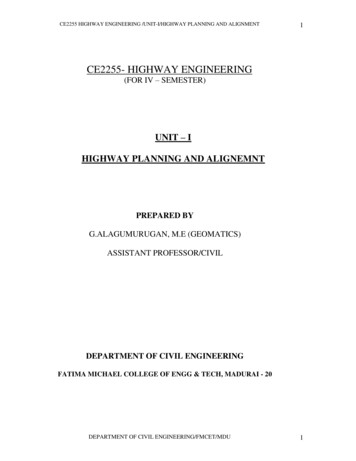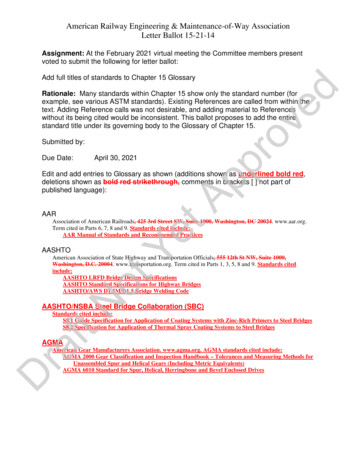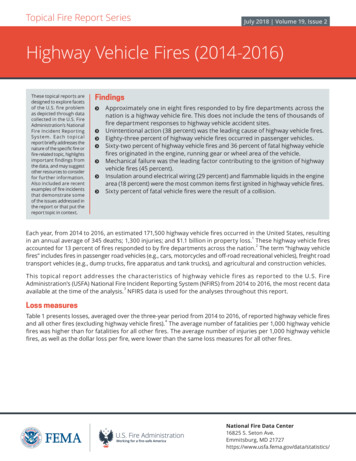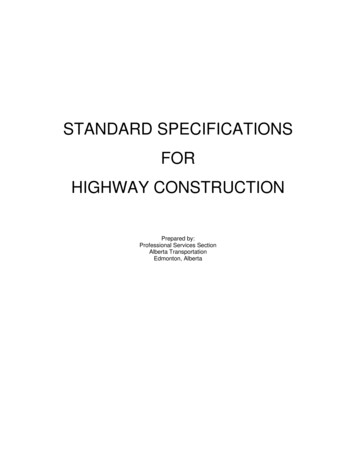
Transcription
STANDARD SPECIFICATIONSFORHIGHWAY CONSTRUCTIONPrepared by:Professional Services SectionAlberta TransportationEdmonton, Alberta
Copyright December, 2010Her Majesty the Queen in right of Alberta, as represented by the Minister ofTransportationThis Book, or parts thereof, may not be reproduced in any form without the writtenpermission ofExecutive Director, Technical Standards BranchAlberta Transportation
SUMMARY OF SPECIFICATIONSSPEC. NO.DESCRIPTIONSection 2 - Grade ingCulvertsRiprapTopsoil PlacementUnderground Electrical ConduitsPerforated Pipe SubdrainsSalvage of Base Course and Pavement MaterialManholes, Inlets and Catch BasinsFencingLivestock GuardsMetal Bin Retaining WallRemoval of Miscellaneous StructuresConcrete and/or Corrugated Steel Storm SewerGuardrail and Guide PostsSeedingCable DuctsPlastic Culvert Extensions and Culvert LinersSmooth Wall Steel Pipe Culvert Extensions and Culvert LinersHighway Street LightingTraffic SignalsSection 3 - 3.213.223.243.26DECEMBER 2010Subgrade PreparationAggregate Production and StockpilingGravel SurfacingAsphalt Stabilized Base CourseGranular Base CourseGranular FillCement Stabilized Base CourseAsphalt Surface TreatmentCold Milling Asphalt PavementSurfacing Bridge DecksPrime, Tack & Fog CoatsSlurry SealDouble Seal CoatGraded Aggregate Seal CoatChip Seal CoatMicro-Surfacing1
SUMMARY OF SPECIFICATIONSSPEC. Asphalt Pavement Crack Routing and SealingAsphalt Pavement Crack SealingCrack Repair - Spray PatchCrack Repair - Mill and FillCutting of PavementAsphalt Concrete Pavement (EPS)Milled Rumble StripsAsphalt Concrete Pavement - SuperpaveSideslope ImprovementSection 4 - Miscellaneous4.14.24.5Asphalt Curb, Medians, Traffic Islands and FlumesConcrete Curbs, Gutters, Sidewalks, Medians and Traffic IslandsHaulingSection 5 - 5.235.245.255.265.275.285.295.305.31DECEMBER 2010Supply of AggregateSupply of Portland Cement ConcreteSupply of AsphaltSupply of Portland CementSupply of Fence MaterialSupply of Reinforced Concrete CulvertSupply of Polyvinyl Chloride PipeSupply of Permanent Highway Signs, Posts and BasesSupply of Line Painting MaterialsSupply of Livestock GuardsSupply and Install Smooth Wall Steel PipesSupply of Corrugated Metal Pipe and Pipe ArchesSupply of Polyethylene PipeSupply of Thrie Beam and W-Beam GuardrailSupply Box Beam Guardrail and PostsSupply of Cable Barrier and Metal PostsSupply Flexible Guide Post Traffic DelineatorsSupply of ReinforcementSupply of Metal Bin Retaining WallGeotextile2
SUMMARY OF SPECIFICATIONSSPEC. NO.DESCRIPTIONSection 6 - Environmental6.56.10Permanent Environmental Protection DevicesGabion and Gabion MattressesSection 7 - Signing and Pavement Markings7.17.27.37.7DECEMBER 2010Traffic Accommodation and Temporary SigningPainted Roadway LinesPavement MessagesPermanent Highway Signing3
Section 2Specification 2.1ClearingTABLE OF CONTENTS2.1 CLEARING . 12.1.1GENERAL. 12.1.1.1Description . 12.1.1.2Clearing in Forest Protection Areas . 12.1.2CLEARING. 12.1.2.1General . 12.1.2.2Clearing and Timber Salvage . 12.1.2.3Preservation of Trees. 12.1.2.4Hazardous Trees. 12.1.3DISPOSAL OF CLEARING DEBRIS . 22.1.3.1Disposal of Clearing Debris by Burning . 22.1.3.2Disposal of Clearing Debris by Mulching . 22.1.4MEASUREMENT AND PAYMENT. 3DECEMBER 2010
Section 22.1CLEARING2.1.1GENERALSpecification 2.1Clearing2.1.1.1 DescriptionClearing shall consist of cutting, piling, removing and disposing of trees, brush, stumps, logsand roots from areas shown on the Drawings or as designated by the Consultant.2.1.1.2 Clearing in Forest Protection AreasClearing in Forest Protection Areas shall be carried out in accordance with the regulations andrequirements of the Alberta Forest and Prairie Protection Act.2.1.2CLEARING2.1.2.1 GeneralThe Contractor shall cut trees and brush within the areas designated for clearing work; anddispose of the resulting debris. Debris from the Contractor’s clearing operations shall not bedeposited on adjacent lands. Burying of material will not be permitted.Branches from standing trees extending into the right-of-way which hang within 6.0 m of theground shall be cut-off close to the trunk in a neat and workmanlike manner. Underbrush anddowned trees protruding into the right-of-way shall be removed and disposed of.At the completion of clearing operations, the limits of the right-of-way shall be left in a conditionsuitable for fencing.2.1.2.2 Clearing and Timber SalvageAreas requiring timber salvage will be identified by the Consultant. Generally, timber salvagewill be required where trees have a stump diameter of 125 mm or greater.The Contractor shall fell, top, limb and deck salvageable timber to the satisfaction of theConsultant. The salvaged timber shall be neatly piled in areas designated by the Consultant.2.1.2.3 Preservation of TreesThe Consultant may require the Contractor to preserve certain trees within the right-of-way.Underbrush, downed timber, snags and roots shall be removed from the vicinity of treesdesignated for preservation and the materials disposed of.2.1.2.4 Hazardous TreesTrees located outside areas to be cleared which, in the opinion of the Consultant, may present ahazard shall be removed and disposed of.DECEMBER 20101
Section 22.1.3Specification 2.1ClearingDISPOSAL OF CLEARING DEBRIS2.1.3.1 Disposal of Clearing Debris by Burning2.1.3.1.1GeneralGenerally, debris resulting from the Contractor’s clearing operations shall be disposed of byburning. Unless otherwise approved by the Consultant, burning of clearing debris shall takeplace within the right-of-way.The Contractor shall obtain authorization from the applicable local authorities prior to burning ofclearing debris within Municipal Districts and Counties.The Contractor is advised that during periods of extreme fire hazard in Forest Protection Areas,fire permits may be refused. In the event the Contractor is unable to burn the debris, through nofault of his own, the Consultant may direct the Contractor to mulch the clearing debris anddispose of it on-site or remove the debris from the right-of-way to his own disposal site.2.1.3.1.2Fire ControlThe Contractor shall be solely responsible for ensuring all fires are carefully controlled and arefully extinguished at the completion of clearing operations. The Contractor may be heldresponsible for damages resulting from improperly extinguished fires.2.1.3.2 Disposal of Clearing Debris by Mulching2.1.3.2.1GeneralWhen specified in the Special Provisions or when directed by the Consultant, the Contractorshall dispose of clearing debris by mulching and spreading the resulting material over thecleared area or other area designated by the Consultant.2.1.3.2.2MulchingMulching shall consist of the breaking down of all non-salvageable timber or snags, brush,shrubs, slash, waste wood and wood debris left after clearing and/or clearing and timbersalvage operations have been completed.Acceptable mulching methods include flailing, rotary cutting and grinding, pulverizing, orchipping. Alternative methods may be used subject to approval by the Consultant.Mulching shall be in accordance with the following requirements:--All mulched materials shall lay flat to the soil. In cases of convoluted or mixedmaterials, the height protruding above the soil level shall not exceed 0.3 m and shallnot exceed a single stem protrusion.No single piece of mulched material shall be longer than 0.5 m and shall not exceed0.07 m in diameter. Exceptions to this requirement may be considered by theConsultant for large diameter woody materials which, upon mechanical manipulation,show evidence of debarking but resist break-up into a size of less than 0.07 m indiameter.DECEMBER 20102
Section 2----2.1.4Specification 2.1ClearingWoody material mulched in-place shall have no residual height requirement.Material mulched and stockpiled and then spread over the cleared areas at a latertime shall have a maximum residual height of 0.07 m.The Contractor shall undertake fringe clean-up operations to remove displacedmaterials in adjacent timber; including tangled or hung-up material, leaning or brokenmaterial, or any material displaced by the mulching process. This also includes anymaterial damaged by the mulching process within proximity to the cleared areadeemed by the Consultant to be a safety hazard.Roadways and adjacent lands shall be inspected for a minimum of 20.0 m from theedge of the property or border of the area cleared. Materials deposited on adjacentlands by the Contractor’s clearing or mulching operations shall be returned to theright-of-way.All stumps shall be reduced to ground level using methods acceptable to theConsultant.Mulching operations shall not incorporate or mix mulched materials into the subsoil.In cases where topsoil is limited, surface mulching operations shall not be allowed tomix topsoil and subsoil horizons.MEASUREMENT AND PAYMENTClearing; clearing and mulching; clearing and timber salvage; and clearing, timber salvage andmulching will be measured in hectares based on horizontal measurements. No allowance willbe made for uneven or sloping ground.Payment for this work will be made at the unit prices bid for "Clearing", “Clearing and Mulching”,Clearing and Timber Salvage” and/or “Clearing, Timber Salvage and Mulching”, as applicable,and will be full compensation for all clearing and/or clearing and timber salvage operations;disposal of debris by burning, mulching or other methods specified by the Consultant; and alllabour, equipment, tools and incidentals necessary to complete the Work to the satisfaction ofthe Consultant.Cutting and removing grain, grass, weeds, brush and shrubs from within areas to be cleared willbe considered incidental to the Work, and no separate or additional payment will be made.If, through no fault of his own, the Contractor is unable to obtain a burning permit and theConsultant directs the Contractor to mulch and spread the clearing debris on-site or dispose ofthese materials off-site, payment for this Work will be made in accordance with Section 1.2.25,Extra Work, of Specification 1.2, General. However, if, in the opinion of the Consultant, theContractor did not make use of opportunities to burn debris when available, these costs will beconsidered incidental to the Work and no separate or additional payment will be made.Clearing of areas required for Contractor access to the Work and for Contractor campsites shallbe carried out by the Contractor at his expense. Payment will not be made for this Work.DECEMBER 20103
Section 2Specification 2.3GradingTABLE OF CONTENTS2.3 GRADING . 12.3.1GENERAL. 12.3.1.1Description . 12.3.1.2Dimensions of Excavations and Embankments. 12.3.2MATERIALS. 12.3.2.1General Description of Suitable and Unsuitable Materials . 12.3.2.2Reservation of Special Materials . 22.3.2.3Description of Topsoil and Subsoil. 22.3.3CLASSES OF EXCAVATION . 22.3.3.1Rock Excavation . 22.3.3.2Channel Excavation . 32.3.3.3Common Excavation . 32.3.3.4Borrow Topsoil Excavation . 32.3.3.5Borrow Excavation . 32.3.3.6Common and/or Borrow Excavation Loaded to Trucks . 42.3.4CONSTRUCTION . 42.3.4.1General Requirements. 42.3.4.2Solid Rock Excavation . 52.3.4.3Catch Water Ditches . 62.3.4.4Common Excavation . 62.3.4.5Borrow Topsoil Excavation . 62.3.4.6Borrow Excavation . 62.3.4.7Constructing Roadways . 102.3.4.8Approach Fills for Bridge Structures (Other Than Bridge Culverts). 162.3.4.9Overhaul. 162.3.4.10 Finishing Previous Clearing . 172.3.5FINISHING, INTERIM ACCEPTANCE OF ROADWAY SURFACES AND MAINTENANCE. 172.3.5.1Finishing. 172.3.5.2Interim Acceptance of Roadway Surfaces. 172.3.5.3Maintenance Requirements and Responsibilities. 182.3.6MEASUREMENT AND PAYMENT. 182.3.6.1General . 182.3.6.2Towing Traffic. 182.3.6.3Slides . 192.3.6.4Maintenance and Traffic Accommodation . 192.3.6.5Rippable Rock Excavation . 192.3.6.6Solid Rock Excavation . 192.3.6.7Channel Excavation . 202.3.6.8Common Excavation . 202.3.6.9Borrow Topsoil Excavation . 202.3.6.10 Borrow Excavation .212.3.6.11 Common and/or Borrow Excavation Loaded to Trucks . 222.3.6.12 Catch Water Ditches. 222.3.6.13 Constructing Embankment . 232.3.6.14 Approach Fills for Bridge Structures (Other Than Bridge Culverts) . 242.3.6.15 Overhaul . 242.3.6.16 Finishing Previous Clearing . 252.3.6.17 Seeding. 252.3.6.18 Reservation of Special Materials . 252.3.7CONSTRUCTION COMPLETION . 25DECEMBER 2010
Section 22.3GRADING2.3.1GENERALSpecification 2.3Grading2.3.1.1 DescriptionGrading consists of the excavation of soil materials, the salvage of select soil materials, theoperation of borrow areas and the construction of embankment. This work includes the removaland/or satisfactory placement of all materials necessary for the construction and preparation ofembankments, slopes, drainage works and connections to the required alignment, grade andcross-sections. It also includes the excavation for culverts, underdrains, and foundation pits forbridges, trestles, buildings and other structures.2.3.1.2 Dimensions of Excavations and EmbankmentsGenerally, the dimensions of the excavations and embankments shall be as shown on theDrawings, however, the dimensions of any or all excavations and embankments may beincreased or decreased at any time by the Consultant as conditions and circumstances dictate.2.3.2MATERIALS2.3.2.1 General Description of Suitable and Unsuitable MaterialsThe following provides a general description of the materials typically encountered duringgrading construction and how such materials shall be handled in the course of carrying out theWork. Specific requirements concerning the use of these materials are detailed elsewhere inthis Specification.Materials considered as "suitable" shall be used for backfilling and constructing embankments.Materials considered as "unsuitable" shall either be disposed of or salvaged depending on thenature of the material.Vegetation, roots, stumps and refuse are considered unsuitable materials. Such materials shallbe disposed of in a manner satisfactory to the Consultant.Topsoil excavated from inside and outside the right-of-way is considered an unsuitable material.Topsoil shall be salvaged and subsequently handled as specified elsewhere in thisSpecification.Subsoil excavated from inside the right-of-way is considered a suitable material. Subsoilexcavated from outside the right-of-way or from a roadway which is to be obliterated isconsidered an unsuitable material and shall be salvaged and subsequently handled as specifiedelsewhere in this Specification.Excess subsoil excavated from dugout borrow sources may be designated as a suitablematerial by the Consultant. Such material will be classified and paid for as borrow excavation.All other excavated material obtained from inside or outside the right-of-way will be consideredsuitable materials, regardless of the moisture content of the material.During the performance of the Work, the Consultant will be the final authority in determiningsuitable and unsuitable materials.DECEMBER 20101
Section 2Specification 2.3Grading2.3.2.2 Reservation of Special MaterialsThe Contractor shall notify the Department immediately whenever gravel, stone or othermaterial which has the potential of being suitable for special use by the Department is found.When required by the Department, such materials shall be reserved and deposited in suitablelocations identified by the Department.2.3.2.3 Description of Topsoil and SubsoilIn this Specification, the terms “topsoil” and ”subsoil” are used to describe separate select soilsrequiring specific handling during construction. The following general descriptions are providedto assist the Contractor in distinguishing these select soils in the course of carrying out theWork. The specific handling requirements for topsoil and subsoil are specified elsewhere in thisSpecification.The uppermost layers of soil both inside and outside the right-of-way may consist of any or all ofthe following. Topsoil is the uppermost layer of soil that:(i)(ii)(iii) Contains the majority of plant roots.Is normally referred to as the plough layer in agriculture soils.Is typically darker in colour than the subsoil layer.Subsoil is the layer of soil directly below the topsoil layer that:(i)(ii)2.3.3Contains the lower portion of the root zone.Is typically lighter in colour than the topsoil layer.CLASSES OF EXCAVATIONAll excavation, for whatever purpose, will be classified as specified herein. The classificationsfor solid rock, channel excavation, common excavation and borrow excavation stipulateexcavating and placing the material. In the event the excavated material is unsuitable, the term"excavating and placing" shall be taken to mean "excavating and stockpiling" or "excavating anddisposing", as applicable.2.3.3.1 Rock Excavation2.3.3.1.1GeneralRock excavation consists of the removal and placement, from its original position, of rock insolid beds or masses, and boulders or detached rock having a volume of 0.5 m3 or greater.2.3.3.1.2Rippable RockWhen identified in the Special Provisions, any rock that can be ripped by a Group 12 dozerequipped with a ripper, as defined in the ARHCA Equipment Rental Rate Guide, and excavatedusing conventional earthmoving equipment will be classified as rippable rock. Excavation of thismaterial will be paid for in accordance with Subsection 2.3.6.5, Rippable Rock Excavation.DECEMBER 20102
Section 22.3.3.1.3Specification 2.3GradingSolid RockRock that cannot be ripped by a Group 12 dozer equipped with a single ripper will be classifiedas solid rock. Excavation of this material will be paid for in accordance with Subsection 2.3.6.6,Solid Rock Excavation.2.3.3.2 Channel ExcavationChannel excavation includes the excavation and placing of material excavated for the followingpurposes: Improvement of existing watercourses.Watercourse channel realignments.Off-set muskeg drainage ditches located parallel to the roadway but not forming the normalcontiguous roadway ditch.Excavation for ditch sections adjoining the roadwayembankment will not be classed as “Channel Excavation”.Trenches excavated for the installation of perforated pipe sub-drains.Trenches excavated for the installation of culverts down to the culvert invert elevation,including sub-excavation for culvert base construction. In cut sections, this is defined as thematerial excavated for culvert installation subsequent to undercut excavation as shown onthe Drawings only. In fill sections, this is defined as the material excavated below originalground only.Material excavated during channel excavation operations which meets the specifications forsolid rock or rippable rock, as described in Subsection 2.3.3.1, Rock Excavation, shall be soclassified.2.3.3.3 Common ExcavationCommon excavation consists of the excavation and placement of material obtained from withinthe right-of-way which does not meet the classification definitions for either “ChannelExcavation” or “Common and/or Borrow Excavation Loaded to Trucks”.Material excavated from stockpiles within the right-of-way and redistributed over disturbed areaswill also be classified as “Common Excavation”.2.3.3.4 Borrow Topsoil ExcavationBorrow Topsoil Excavation shall consist of the excavation and salvage of topsoil, and subsoilseparately from borrow areas and borrow area haul roads. Such materials excavated from astockpile and redistributed on borrow areas and borrow area haul roads shall also be classifiedas "Borrow Topsoil Excavation".2.3.3.5 Borrow ExcavationBorrow Excavation shall consist of the excavation and placing of material obtained fromlocations outside the right-of-way with the following exceptions:(i)The excavation of roadways which are being obliterated will be classified as CommonExcavation.(ii) With the exception of topsoil and subsoil excavated from outside the right-of-way asdescribed in 2.3.3.5 (i), all other topsoil and subsoil excavated from outside the right-of-waywill be classified as Borrow Topsoil Excavation.DECEMBER 20103
Section 2Specification 2.3Grading2.3.3.6 Common and/or Borrow Excavation Loaded to TrucksCommon and/or Borrow Excavation Loaded to Trucks consists of the excavation, loading totrucks and placing of material obtained from locations inside the right-of-way or borrow areas asshown on the Drawings or as designated in the Special Provisions. Any material not designatedto be loaded to trucks will not be so classified.2.3.4CONSTRUCTION2.3.4.1 General Requirements2.3.4.1.1Restraining of LivestockThe Contractor shall erect and maintain such temporary fences as may be required to preventlivestock or other animals from straying upon the right-of-way or adjoining property or uponborrow area perimeters. The Contractor shall at all times provide against the escape oflivestock or other animals through openings made by him in right-of-way or other fences.2.3.4.1.2Towing TrafficWhere necessary during grading operations, the Contractor shall, upon orders in writing fromthe Consultant, provide sufficient men and equipment to hookup and tow vehicular trafficthrough the Work. The amount and type of equipment to be used in towing traffic will bestipulated and approved in the orders by the Consultant. The Contractor shall be responsiblefor the hookup of towed vehicles, and shall be responsible for any damage caused by suchhook-up and towing.2.3.4.1.3Equipment Operation on Paved SurfacesWhere the location of excavation material necessitates the hauling across or on an existingpaved roadway the operation shall be carried out as follows:(i)Haul across an existing roadway shall be limited to a single equipment crossing point foreach borrow site approved by the Consultant.(ii) Where haul across a road is by conventional earth moving equipment, an earth pad or steelplates of sufficient dimensions shall be placed on the existing road surface so that nodamage to the highway surface or roadbed is incurred. Steel plates may remain in placethroughout the use of the crossings.Unless otherwise permitted by the Consultant, earth pads shall be placed no sooner thandaybreak and removed no later than sunset each day that haul operations are in progress.In all cases, the use of earth pads on existing roads must be addressed by the Contractorin his Traffic Accommodation Strategy.(iii) Where haul along or across a road is undertaken by trucks, the prevalent load limitrestrictions for haul along roadways or over bridges shall apply. Haul of excavationmaterial on the existing roadway will only be permitted until completion of sufficient newgrade.(iv) Under no circumstances shall regular grading equipment be allowed to operate on theexisting highway surface or use the highway surface as a haul road.(v) Dust abatement material shall be applied when necessary.DECEMBER 20104
Section 2Specification 2.3GradingRepair of any damage incurred in the pavement or subgrade structure, as a result of the hauloperations, shall be the sole responsibility of the Contractor. The damage shall be repaired andthe surface restored to a condition equivalent to that which existed prior to the commencementof haul operations.2.3.4.1.4Preservation of Survey MonumentsThe Contractor shall preserve all survey monuments and property marks along and adjacent tothe roadway. The Contractor shall use suitable precautions to protect from damage ordisturbance such survey monuments and property marks until their location has beenwitnessed, or otherwise referenced, and he shall not remove them until directed by theConsulta
Section 2 Specification 2.1 Clearing DECEMBER 2010 2 2.1.3 DISPOSAL OF CLEARING DEBRIS 2.1.3.1 Disposal of Clearing Debris by Burning 2.1.3.1.1 General Generally, debris resulting from the Contractor's clearing operations shall be disposed of by








